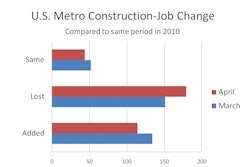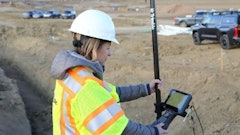The American Road & Transportation Builders Association (ARTBA) has developed a comprehensive new publication that provides salary and wage information for 112 occupations in the transportation design and construction industry, including management, engineering, construction, finance, administrative and safety-related positions.
The “2011 U.S. Highway, Street & Bridge Construction Salary & Hourly Wage Guides” contain data for national, state, urban and rural areas so that you can benchmark your company’s wages against competitors.
The guides utilize just-released (May 2011) data from the U.S. Department of Labor’s Bureau of Labor Statistics (BLS). The BLS project collected wage and salary information from all U.S. business sectors and includes data and estimates for 350,000 employees working at construction firms that classified their primary business as “highways, streets and bridges.”
Detailed national and 50 state guides can be found at www.artba.org/salaryguide.
The national report, available for $150 (ARTBA members) and $200 (non-members), features salary and wage information for all highway, street and bridge contractors across the U.S.
The state level guides, priced at $250 (ARTBA members) and $300 (non-members), include the same national and state level data, along with information for both urban and rural areas.
For each occupation, you will find the average and median annual salary and hourly wage paid, as well as break-points for both at the 10th, 25th, 75th and 90th percentiles, where available. Each state guide is divided into four sections:
- A weighted-average picture of how all highway, street and bridge construction firms collectively in the U.S. are compensating their employees. This allows you to see how your firm’s compensation structure compares within the industry as a whole.
- What your competition for talent in a specific state is paying their employees. These data are not highway, street and bridge construction firm-specific. They reflect what all business sectors within the state or local area are paying for individual occupations. In today’s employment marketplace, your competition for talent isn't just the other transportation construction firms in the area; it is all other firms and public agencies in the area as well—regardless of the industry.
- Detailed wage and salary information for all occupations, just like the state information, but broken out into local urban and rural areas. The total number of local areas varies depending on the state, but each guide includes all major metropolitan areas.
- Detailed occupational definitions developed by the U.S. Department of Labor for each position documented. Individual transportation construction firms used these descriptions to complete their surveys.
The 2011 guides were developed by an ARTBA economics research team led by Alison Premo Black, the association’s vice president of policy and senior economist. Ms. Black is an economics doctoral candidate at The George Washington University in the Nation’s Capital, and holds an M.A. in International Economics and Latin American Studies from the Johns Hopkins School of Advanced International Studies.



















